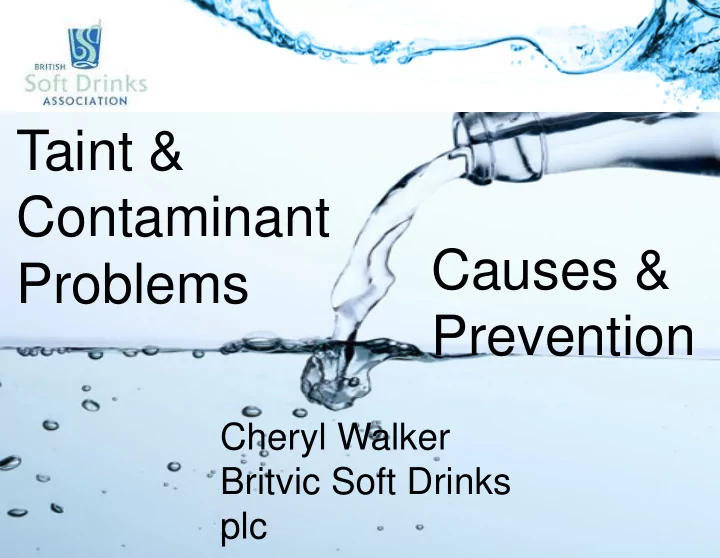

Taint & Contaminant Causes & Problems Prevention Cheryl Walker Britvic Soft Drinks plc
Scope • Taints & contaminants – what’s the difference? • Tasting • Families of taints & their causes • Prevention • Conclusion
Taints • Taints are off flavours or odours arising from changes within the water as extracted from source. These off flavours or odours are caused by reactions within the water due to the chemistry of the water or the interaction of the water with packaging, or post production storage conditions. • Types of taint – Headspace – Within product
Contaminants • Contaminant – this is a substance which is introduced to the product during production or storage and which may cause an off odour or flavour in product. Contaminants are materials that have entered the water during extraction, bottling or post production.. They may not result in an off taste or aroma!
What’s the difference? • Taints develop within the water due to the natural chemistry of the water interacting with it’s environment either as the result of heightened levels of organic material (NOM) or unstable elements (Sulphur, Iron). • Contaminants enter the water at any point of production – they are an additional material to the natural composition of the water. Examples include the presence of plasticisers leached from packaging.
Sensory summary • Water has a very subtle taste • Panels have to be specifically trained on water Food safe flavour analogues
Descriptors The drinking water taste and odour wheel (Suffet et al., 1999) and (b) the wastewater odour wheel for evaluating wastewater treatment odours (Burlingame et al., 2004)
Contaminants Sand grains from a sand filter
Calcite particles in mineral water Naturally occurring particles – from groundwater – sometimes reported as foreign bodies in bottled water.
Off Smells & Tastes • Drains, cabbagey – sulphur – line issue • Musty/Mouldy – MIB (2-methylisoborneol) or TCA (Trichloroanisole)– water issue • PET bottles– Packaging & Shelf life issue (still) • acetaldehyde – sweet • Styrene - plastic • Sulphur – selenite in water reacting with PET • PET & Glass bottles – Carbonates - Product • Sulphur taint - from Carbon dioxide
Odour Thresholds Chemical Size of panel Geometric mean Lowest odour threshold concentration at concentration which an odour (ug/l -1 ) was detected (ug/l -1 ) Geosmin 10 0.0038 0.0013 (4 testers)) 2-isobutyl-3- 8 0.001 <0.00005 methoxypyrazine (1 tester) 2-isopropyl-3- 6 0.0002 <0.00003 methoxypyrazine ( 2 testers) 2-methyl-isoborneol 10 0.015 0.0063 ( 2 testers)
Sources of taints and contamination • Borehole • Wellhead • Filters • Production Line • Post production storage • Packaging
Water source • Groundwater -microbiological • Chemical - SO2 • Soil metabolites • Surface water – algal • Haloanisoles • pollutants
Examples • Sporadic taints – when the concentration of naturally present compounds increases to detectible levels. • Often result from soil saturation, they are unpredictable and may only affect 1 or 2 bottles in a case; or a few minutes filling time. • Compounds formed by the geology and microflora of the wellfield and catchment
Microbial Taints Taken from DWI Report 2001
Taints of particular interest
Taints - Families
Issues caused by Water Storage
Production Line • Pipework - biofilms • Jointing/welding compounds • Dead legs • Connections – valves – one way & otherwise • Sample points
Preventative measures • Avoid plastic pipework • Make sure that any welding or sealing compounds used are fit for purpose • Keep pipework runs short • Carry out sensory after any engineering work is carried out.
Gases • Ingredient gases – naturally carbonated waters • CO2 • Blowers – air • Top gas- N2 - from tanker/transfer lines
Sampling CO 2 • CO 2 is collected into the sampling device to form a snow pellet. • It is then checked for off odour due to sulphur or hydrocarbon compounds • Image & process taken from EIGA tanker driver manual h ttp://www.eiga.eu
Snow cap sampling device • This is an alternate device used to check compressed gas deliveries. • Again a pellet is captured and then checked for off odours. • Courtesy B. Watson of A G Barr
Taint Identification Process Sample retrieval/ Off flavour Information reference samples reported gathering obtained Analysis RCA Identification of taint/contaminant
Post Process taints • Light struck – prolonged exposure can cause tainting • Poor storage off flavours adsorbed through packaging if product stored near other products with strong • Packaging – selenite in PET; acetaldehyde formation over shelf life • Algae
Summary • Taints and contaminants can arise at any point in the abstraction, bottling and storage of bottled water. • Good well, source and risk management reduce the likelihood. • Sporadic taints can arise at any time but it is possible to identify periods of high risk and increase sampling to mitigate the risk
Some Useful References • For descriptors: Food Taints and Off-Flavours M.J. Saxby 2 nd edition, Springer ISBN978-0-7514-0263-6 Softcover ISBN978-1-4613-5899-2 Useful specialised websites (www.odour.org.uk; www.flavornet.org). • Technology of Bottled Water edited by Nicholas Dege • Flavour Development, Analysis and Perception in Food and Beverages edited by J K Parker, Stephen Elmore, Lisa Methven • Investigations into Off-flavours in PET bottled Mineral Water due to Sunlight Exposure Fraunhofer Institute for Process Engineering and Packaging (IVV), Giggenhauser Straße 35, 85354 Freising, Germany,
Thank You
Recommend
More recommend